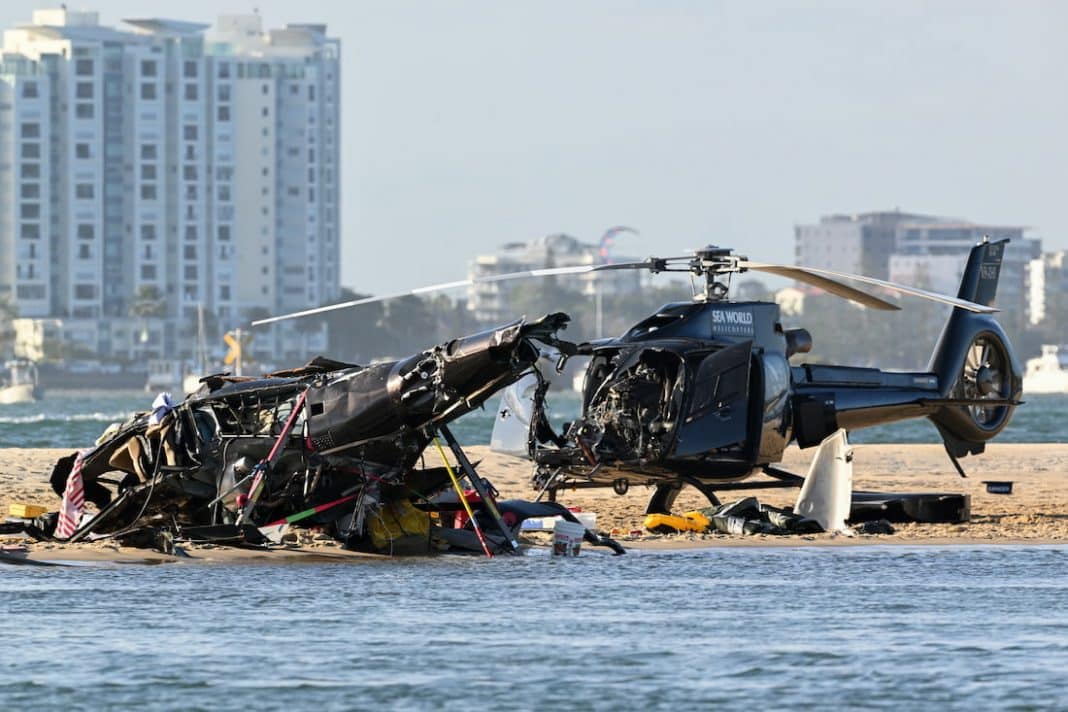Three pilots don’t recall hearing a counterpart on radio before his helicopter collided with another, killing him and three other people on the Gold Coast.
The Australian Transport Safety Bureau hasn’t found any recordings of radio calls made by the four helicopter pilots flying in the Sea World area on January 2 due to the low height of their aircraft.
One of the pilots in the crash, Michael James, told investigators he saw passengers boarding his colleague Ashley Jenkinson’s helicopter (XKQ) and thought the other aircraft would pass behind him.
“They did not recall the pilot of XKQ making a standard “taxiing” call announcing their intention to depart,” the ATSB’s preliminary report said.
Two other helicopter pilots conducting flights from the nearby Marina Mirage at the time were also interviewed about the radio communications.
One recalled hearing Mr James’ inbound call but not Mr Jenkinson’s taxiing call, while the second Marina Mirage pilot didn’t recall hearing either.
ATSB commissioner Angus Mitchell stressed that that evidence “did not necessarily mean a taxiing call was not made” by Mr Jenkinson and investigators would probe the radio calls in the lead-up to the crash.
The report said Mr James also told the ATSB he didn’t see Mr Jenkinson’s helicopter take off from the helipad.
“While video footage taken by passengers in both helicopters on mobile phones contained images of the other helicopter, this does not mean the other helicopter was visible to either pilot,” Mr Mitchell said.
“The investigation will look closely at the issues both pilots faced in seeing the other helicopter.”
Sea World Helicopters had fitted both helicopters with traffic collision avoidance systems, despite that not being required.
However the systems hadn’t been integrated and were only able to issue audio alerts with Mr James saying he didn’t hear any alert before the accident.
Mr James’ aircraft also wasn’t transmitting secondary surveillance radar responses about its position and altitude at the time with Sea World Helicopters aware of the problem.
“The aircraft was not able to be used in controlled airspace until it was rectified. Efforts to diagnose and address the transponder problem were ongoing,” the ATSB said.
“A review of all avionics and pilot assistance systems, and radar and surveillance information, is ongoing.”
Mr Jenkinson, 40, and his passengers including British couple Ron and Diane Hughes, 65 and 57, and Sydney mother Vanessa Tadros, 36, died when their helicopter crashed.
Ms Tadros’ son Nicholas, 10, has been undergoing procedures in hospital since the accident and last week had his leg amputated from the knee down.
Victorian mother Winnie de Silva, 33, and her nine-year-old son Leon are recovering from injuries sustained in the crash.
Mr James managed to land his aircraft safely but he and two of his passengers were injured by flying glass when its windshield shattered.
The injured were New Zealand women Elmarie Steenberg and Marle Swart, who had been on holiday with their husbands Riaan Steenberg and Edward Swart.
The full ATSB report into the collision by the Air Transport Safety Bureau is not expected until at least September 2024.



